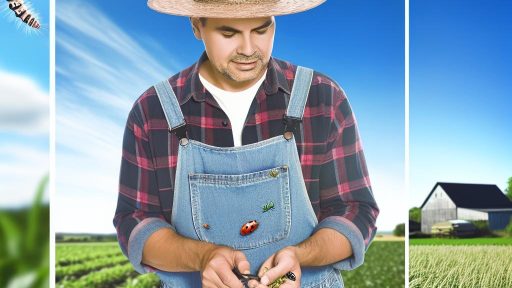Introduction to Integrated Pest Management
Definition of Integrated Pest Management
Integrated Pest Management, or IPM, is a comprehensive approach to pest control.
It combines various management strategies to minimize pest damage.
This method focuses on sustainable practices rather than reliance on chemical solutions.
Importance of Integrated Pest Management in Modern Agriculture
IPM plays a crucial role in modern agriculture by promoting sustainable practices.
It helps farmers reduce reliance on pesticides, thereby protecting the environment.
Additionally, it enhances crop yield by managing pest populations effectively.
Key Components of Integrated Pest Management
The first component of IPM is identifying pests accurately.
Farmers should monitor pest levels regularly to determine action thresholds.
Furthermore, they should utilize biological controls, such as beneficial insects.
Cultural practices, such as crop rotation, are also vital for pest management.
Incorporating mechanical controls can further decrease pest populations.
Benefits of Using Integrated Pest Management
One significant benefit is the reduction of chemical pesticide use.
Less pesticide use leads to a healthier ecosystem.
Moreover, IPM fosters biodiversity and resilience in agricultural systems.
This approach also results in cost savings for farmers over time.
Transform Your Agribusiness
Unlock your farm's potential with expert advice tailored to your needs. Get actionable steps that drive real results.
Get StartedLastly, it meets consumer demand for sustainably-grown food products.
Impact of Climate Change on Pest Populations and Agricultural Biodiversity
Changing Weather Patterns
Climate change alters weather patterns across the globe.
For instance, increased temperatures can expand pest ranges.
Moreover, altered rainfall patterns affect crop resilience.
This combination creates challenges for farmers managing pest populations.
Pest Population Dynamics
Warmer temperatures benefit many pests’ reproductive cycles.
Consequently, pest populations grow more rapidly in certain regions.
Additionally, milder winters fail to control pest populations.
This leads to more frequent infestations during growing seasons.
Impact on Agricultural Biodiversity
The rise in pest populations threatens agricultural biodiversity.
Monoculture practices exacerbate this situation significantly.
Loss of biodiversity weakens the ecosystem’s resilience.
Farmers face increased vulnerability to pest outbreaks and diseases.
Emerging Pest Species
Climate change facilitates the spread of invasive pest species.
New pest species adapt to changing climates more easily.
This leads to increased competition for resources among native pests.
The introduction of new pests can disrupt local agricultural systems.
Strategies for Farmers
Farmers need to adopt integrated pest management strategies.
These strategies help mitigate the impacts of climate change.
Additionally, they promote sustainable agricultural practices.
Ultimately, innovative approaches ensure food security in a changing environment.
Key Components of IPM
Biological Strategies
Biological strategies enhance natural pest control mechanisms.
These include promoting beneficial insects such as ladybugs and lacewings.
Farmers can also introduce microbial agents to suppress pest populations.
Showcase Your Farming Business
Publish your professional farming services profile on our blog for a one-time fee of $200 and reach a dedicated audience of farmers and agribusiness owners.
Publish Your ProfileOverall, these methods foster biodiversity and ecosystem health.
Cultural Strategies
Cultural strategies aim to modify farming practices to deter pests.
This involves crop rotation to disrupt pest life cycles.
Farmers can also select pest-resistant crop varieties.
Moreover, adjusting planting times can minimize pest threats.
Efficient irrigation practices prevent pest proliferation by eliminating standing water.
Mechanical Strategies
Mechanical strategies utilize physical barriers and tools to manage pests.
Installation of row covers shields crops from insect access.
Additionally, traps can be employed to capture pests effectively.
Regular tillage disrupts the habitat of soil-dwelling pests.
Ultimately, these methods reduce reliance on chemicals.
Chemical Strategies
Chemical strategies involve the judicious use of pesticides.
Selecting the right product minimizes environmental impact.
Farmers should apply chemicals according to pest thresholds.
This ensures that treatment is necessary and effective.
Integrated use of chemicals with other strategies is key to IPM success.
You Might Also Like: The Connection Between Land Erosion and Flood Risks in Real Estate
Assessment of Climate-Smart IPM Practices: Case Studies from Different Regions
Introduction to IPM in Changing Climates
Integrated Pest Management (IPM) adapts to changing climate conditions.
This approach combines various management strategies for effective pest control.
Farmers increasingly implement climate-smart practices globally.
Case Study: Subtropical Agriculture in Florida
Florida’s subtropical climate poses unique challenges for pest management.
Farmers use neem oil as a natural pesticide to combat pests.
This method reduces harm to beneficial insects like honeybees.
Additionally, farmers have shifted to cover cropping to enhance soil health.
These practices have improved crop resilience against pests.
Case Study: Temperate Agriculture in Germany
In Germany, climate change has led to shifting pest populations.
Farmers employ crop rotation to disrupt pest cycles effectively.
This strategy also enhances soil nutrient availability.
Moreover, they utilize biocontrol agents, such as ladybugs, for aphid control.
This approach promotes biodiversity while managing pest populations.
Case Study: Arid Regions in Australia
Australian farmers face increasing challenges due to arid conditions.
They adopt irrigation practices that minimize water use.
Additionally, integrated pest management techniques are essential in these areas.
Farmers also practice targeted insecticide application based on pest monitoring.
This method reduces overall chemical use and protects the environment.
Comparative Analysis of Effectiveness
Comparing case studies reveals diverse approaches across regions.
Farmers in Florida emphasize natural pesticides, while German growers focus on crop rotation.
This comparison highlights the adaptability of IPM strategies.
Furthermore, Australian farmers showcase the importance of resource efficiency.
Each region’s unique climate requires tailored management solutions.
Showcase Your Farming Business
Publish your professional farming services profile on our blog for a one-time fee of $200 and reach a dedicated audience of farmers and agribusiness owners.
Publish Your ProfileChallenges and Opportunities
Implementing climate-smart IPM faces challenges, such as limited resources.
Some farmers lack access to necessary training and education.
However, targeted support can enhance knowledge and implementation.
Collaboration between farmers and researchers offers new opportunities.
This partnership can lead to innovative solutions for pest management.
You Might Also Like: Effects of Wildfires on Agricultural Real Estate in the United States
Monitoring and Forecasting Pest Outbreaks
The Role of Technology
Technology plays a crucial role in pest management strategies.
Farmers can utilize various technological tools to monitor pest populations.
Remote sensing devices provide real-time data on crop conditions.
These devices help farmers track environmental variables affecting pests.
Furthermore, drones can scout large fields efficiently and effectively.
Predictive Tools for Pest Management
Predictive tools are essential for anticipating pest outbreaks.
Models based on historical data can forecast potential infestations.
For instance, tools like PestCast utilize weather data to predict pest behavior.
These predictions empower farmers to take proactive measures early.
Reliable forecasts can significantly reduce crop damage from pests.
Data Collection and Analysis
Data collection is vital in understanding pest dynamics.
Farmers should gather information about pest life cycles and behaviors.
Moreover, analyzing this data helps improve management strategies.
Farm management software integrates data sources for comprehensive analysis.
This integration enables farmers to make informed decisions swiftly.
Collaboration and Knowledge Sharing
Farmers can benefit from collaboration with agronomists.
Sharing knowledge about pest outbreaks enhances collective management efforts.
Participating in regional pest management networks fosters collaboration.
Through these networks, farmers can access valuable resources and advice.
Ultimately, collective action leads to more effective pest management.
Learn More: Ways to Prevent Pest Infestations Near Agricultural Real Estate

Integration of Crop Rotation and Diversity in Pest Management Plans
Importance of Crop Rotation
Crop rotation significantly disrupts pest life cycles.
This strategy prevents pests from becoming too established.
Furthermore, rotating crops decreases soil nutrient depletion.
Different crops attract varied pest communities.
This diversity reduces pest populations effectively.
Diversifying Crop Plantings
Diverse crop plantings enhance ecological balance on farmland.
This approach encourages beneficial insects and natural predators.
In addition, it improves soil health and resilience.
Farmers can vary planting schedules to maximize diversity.
Different planting dates help evade synchronized pest outbreaks.
Implementing Integrated Pest Management
Integrated Pest Management (IPM) combines multiple strategies.
Farmers must evaluate pest populations regularly.
Effective monitoring allows for timely intervention.
Showcase Your Farming Business
Publish your professional farming services profile on our blog for a one-time fee of $200 and reach a dedicated audience of farmers and agribusiness owners.
Publish Your ProfileIPM emphasizes using non-chemical methods first.
Natural predators can often keep pest numbers low.
Case Studies of Successful Practices
Successful farmers have reported benefits from these practices.
Emily Thornton shared her experience with crop rotation.
She rotated cover crops every season to enhance soil quality.
As a result, her yields improved alongside pest management.
Future Challenges and Adaptations
Climate change introduces new pest pressures for farmers.
Adapting pest management strategies will be crucial.
Investing in research can foster resilience in crop systems.
Collaboration among farmers will lead to better solutions.
Ultimately, adaptability will define successful pest management.
Delve into the Subject: How Climate-Smart Crops Impact Farmland Profitability
Soil Health Management as a Foundation for Resilient Pest Control
The Importance of Soil Health
Healthy soil is crucial for successful agriculture.
It affects the growth of crops and overall yield.
Moreover, healthy soil fosters beneficial organisms.
These organisms help in pest management and nutrient cycling.
Basic Principles of Soil Health Management
Sue to its importance, soil health management relies on several key practices.
Crop rotation enhances soil fertility and pest resistance.
Cover cropping prevents erosion and enriches the soil.
Addition of organic matter boosts microbial life.
Regular soil testing guides nutrient management.
Integrating Pest Control Tactics
Integrating pest control requires a holistic approach.
Biological controls aid in managing pest populations naturally.
For instance, introducing beneficial insects enhances natural control.
Additionally, minimal tillage preserves soil structure and organisms.
Adapting to Climate Change
Climate change presents unique challenges for farmers.
Adapting soil health practices can mitigate these risks.
For example, increasing organic matter improves moisture retention.
This practice helps crops withstand drought conditions.
Community Engagement and Education
Community involvement is vital for sustainable practices.
Farmers can benefit from local workshops and information sharing.
Collaborative efforts enhance knowledge on best practices.
Furthermore, sharing experiences encourages innovation in pest management.
Collaboration between Farmers, Researchers, and Extension Services for Effective IPM Implementation
Importance of Collaboration
Collaboration is essential for effective Integrated Pest Management (IPM).
It brings together diverse expertise and perspectives.
Farmers understand local conditions and pest pressures.
Researchers offer scientific knowledge and innovative solutions.
Extension services provide training and resources to implement IPM practices.
Establishing Partnerships
Building partnerships is key to successful collaboration.
Farmers should engage with local universities and research institutions.
Showcase Your Farming Business
Publish your professional farming services profile on our blog for a one-time fee of $200 and reach a dedicated audience of farmers and agribusiness owners.
Publish Your ProfileSharing knowledge fosters mutual understanding and support.
Organizations like the Agricultural Research Service play pivotal roles.
Regular meetings and workshops enhance communication and trust.
Training and Education Programs
Effective IPM requires ongoing training for farmers.
Workshops can cover pest identification and management strategies.
Extension services should develop accessible educational materials.
Webinars and online resources expand outreach to rural areas.
Farmers should actively participate in these programs to stay informed.
Utilizing Data and Technology
Data-driven decision-making enhances IPM effectiveness.
Farmers must share pest data with researchers regularly.
Technological tools can analyze trends and predict pest outbreaks.
Remote sensing and mobile apps facilitate real-time data access.
Feedback and Continuous Improvement
Regular feedback loops between farmers and researchers are vital.
Farmers should report the outcomes of implemented practices.
This feedback aids researchers in refining their approaches.
Continuous improvement ensures IPM strategies remain effective.
Creating Community Support Networks
Local farming communities should foster support networks.
These networks can share experiences and solutions effectively.
Collaborative pest management projects can lead to shared successes.
Community engagement increases the adoption of sustainable practices.
Additional Resources
Climate Change to Drive Surge in Insects That Attack Almonds …
Climate Change Consortium for Specialty Crops: Impacts and …




